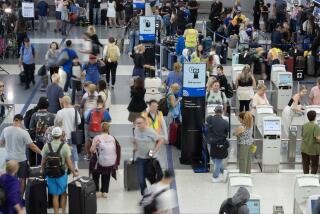LAX Crash Involved Top-Secret Building : Security: Structure was struck by a jet in February runway collision. It was first described as an abandoned fire station.
A Los Angeles International Airport official confirmed Wednesday that a concrete-block building struck by a jetliner during last Februaryâs disastrous runway crash is used to house secret security operations of the FBI and other agencies--and is not just an abandoned fire station, as officials had previously reported.
âWe use it as a command post,â airport manager Steve Yee said. âSome surveillance is conducted from there. It has special equipment. . . .
âI canât tell you exactly what is in it,â Yee added. âI donât want to make it a bigger target than it is.â
Yee was responding to a published report that the building actually contains the West Coast command headquarters of a secret FBI anti-terrorist organization.
The FBI has never officially acknowledged the existence of such a unit, and agents at the agencyâs regional office in Westwood declined comment on Wednesday, saying their spokesman, John Hoos, was not in the office on Christmas and would not return until today.
However, seven years ago, the FBI revealed that it had developed elite hostage rescue teams manned by specially trained agents. The agents, said to be armed with submachine guns and to wear hooded jumpsuits, made up a key element of the countryâs counter-terrorism forces.
Yee said Wednesday that the FBI moved into the building shortly after the Los Angeles Fire Department moved out on May 21, 1985. He said the FBI and other agencies, which he declined to name, are still using the former fire station.
âItâs a multi-agency facility, to put it exactly,â the airport manager said. He declined to elaborate further, other than to say that the structure is used âfor security emergencies.â
Last Feb. 1, a USAir Boeing 737 jetliner landing at dusk crashed into a SkyWest commuter plane cleared for takeoff on the same runway. The mangled wreckage of the two aircraft skidded across a taxiway, slammed into the building and exploded in flames. All 12 aboard the smaller plane and 22 of the 89 aboard the jetliner were killed.
News crews attempting to cover the incident were kept about 100 yards from the building.
âThey said we couldnât get any closer. There was still fuel (in the wreckage) and I guess that meant there could be a danger of more fire,â said Marsha T. Gorman, a Times staff photographer who went to the site a day after the crash. âThey told us the building was just an old firehouse.â
But the reports published in Wednesdayâs editions of the Wave Newspapers suggested that concerns over maintaining secrecy about the real use of the building were what prompted officials to keep the news media at bay.
According to the Wave report, which cited unnamed sources, the structure contained sophisticated FBI computer equipment and other high-technology electronic gear at the time of the crash.
The sources were quoted as saying that by 6 a.m. the day after the crash, the equipment had all been removed under cover of darkness. Both Yee and the Wave sources indicated that the equipment has since been returned and the security operations have been resumed.
Last October, federal investigators issued their final report on the Feb. 1 crash, blaming it on inept management of the airport control tower. Even though the issue was never raised by the investigators, the FBI took the unusual step shortly after the incident of putting out a statement specifically ruling out terrorism.
While the FBI and other agencies are generally reluctant to discuss their anti-terrorist activities, the bureau did tip its hand on March 9, 1984, when it staged a mock rescue of supposed hostages at an FBI facility in Quantico, Va.
Although the FBI invited the news media to publicize the maneuvers, many of the hostage teamsâ techniques were kept secret, including the types of equipment used and the methods of deployment.
FBI officials said they staged the maneuvers to demonstrate the agencyâs readiness to deal with any terrorism at the then-pending Summer Olympics in Los Angeles and Worldâs Fair in New Orleans.
The Worldâs Fair and the 1984 Olympics passed without any terrorist activities, but on Dec. 21, 1988, a Pan American World Airways jetliner exploded over Lockerbie, Scotland, killing 270 in a crash later blamed on terrorist activities by Libyan agents.
The Lockerbie crash focused attention on airlinersâ vulnerability to terrorist attacks, and security at most U.S. airports has been intensified since then.
William Webster, the FBI director at the time, said the anti-terrorist teams represented a âsubstantial deterrent to any foreign terrorist (operation) that might be directed at our shores.â In addition to these teams, the FBI has acknowledged the existence of Special Weapons and Tactics (SWAT) teams at each of the 59 field offices across the nation.
More to Read
Sign up for Essential California
The most important California stories and recommendations in your inbox every morning.
You may occasionally receive promotional content from the Los Angeles Times.










